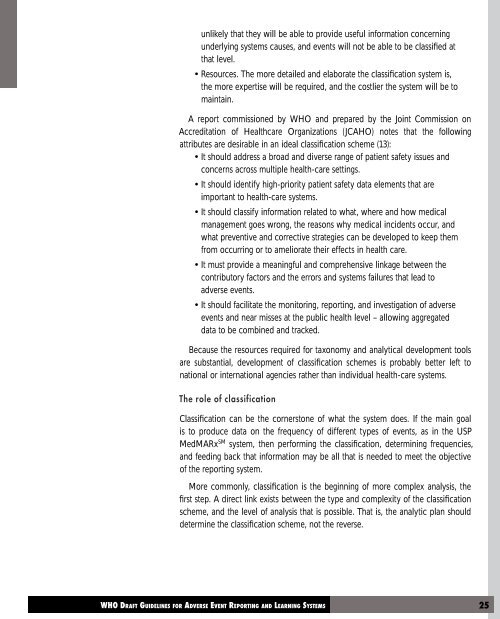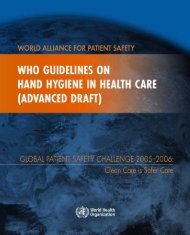Adverse event reporting.pdf
Adverse event reporting.pdf
Adverse event reporting.pdf
You also want an ePaper? Increase the reach of your titles
YUMPU automatically turns print PDFs into web optimized ePapers that Google loves.
unlikely that they will be able to provide useful information concerning<br />
underlying systems causes, and <strong>event</strong>s will not be able to be classified at<br />
that level.<br />
• Resources. The more detailed and elaborate the classification system is,<br />
the more expertise will be required, and the costlier the system will be to<br />
maintain.<br />
A report commissioned by WHO and prepared by the Joint Commission on<br />
Accreditation of Healthcare Organizations (JCAHO) notes that the following<br />
attributes are desirable in an ideal classification scheme (13):<br />
• It should address a broad and diverse range of patient safety issues and<br />
concerns across multiple health-care settings.<br />
• It should identify high-priority patient safety data elements that are<br />
important to health-care systems.<br />
• It should classify information related to what, where and how medical<br />
management goes wrong, the reasons why medical incidents occur, and<br />
what pr<strong>event</strong>ive and corrective strategies can be developed to keep them<br />
from occurring or to ameliorate their effects in health care.<br />
• It must provide a meaningful and comprehensive linkage between the<br />
contributory factors and the errors and systems failures that lead to<br />
adverse <strong>event</strong>s.<br />
• It should facilitate the monitoring, <strong>reporting</strong>, and investigation of adverse<br />
<strong>event</strong>s and near misses at the public health level – allowing aggregated<br />
data to be combined and tracked.<br />
Because the resources required for taxonomy and analytical development tools<br />
are substantial, development of classification schemes is probably better left to<br />
national or international agencies rather than individual health-care systems.<br />
The role of classification<br />
Classification can be the cornerstone of what the system does. If the main goal<br />
is to produce data on the frequency of different types of <strong>event</strong>s, as in the USP<br />
MedMARx SM system, then performing the classification, determining frequencies,<br />
and feeding back that information may be all that is needed to meet the objective<br />
of the <strong>reporting</strong> system.<br />
More commonly, classification is the beginning of more complex analysis, the<br />
first step. A direct link exists between the type and complexity of the classification<br />
scheme, and the level of analysis that is possible. That is, the analytic plan should<br />
determine the classification scheme, not the reverse.
















